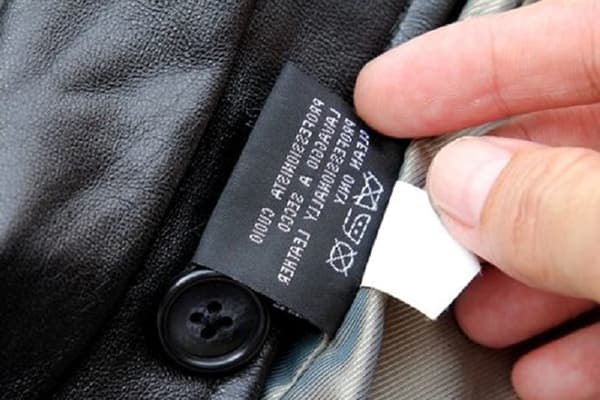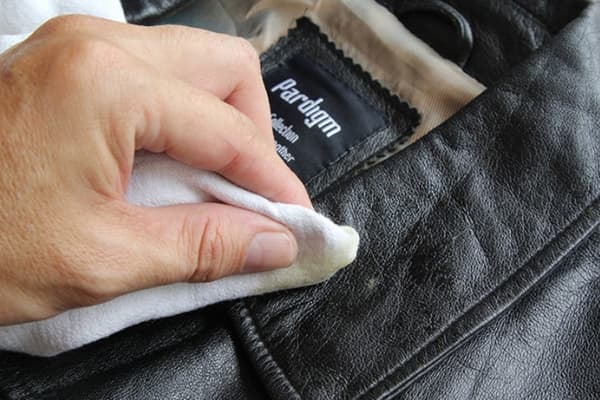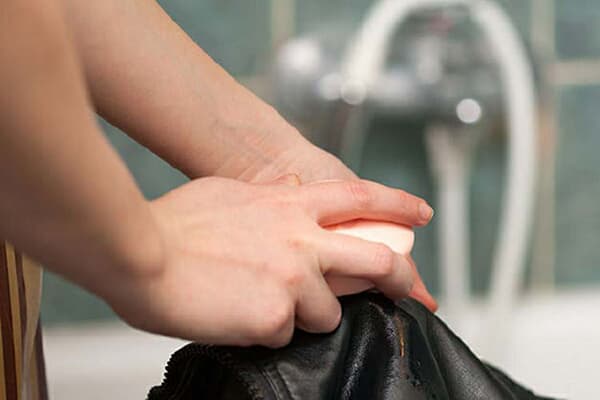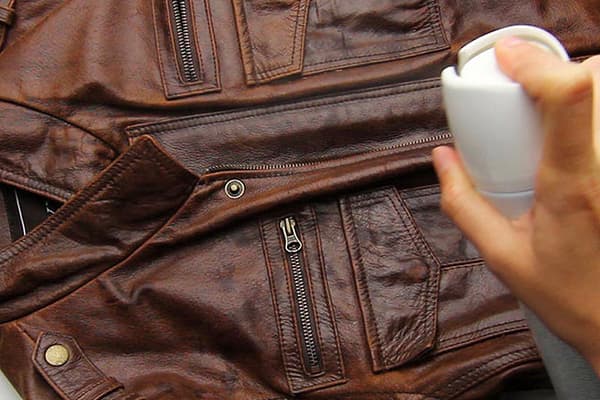Is it possible to wash a leather jacket in a machine or at least by hand?
It is not recommended to wash a leather jacket either in a machine or by hand. It’s another matter if the product is made of artificial leather. In this case, things can be washed both manually and automatically, but certain conditions must be observed.

Why can't you wash a leather jacket?
For sewing jackets, Merino or coarse-wool sheep skins are usually used. Natural material is subjected to special finishing, which includes several stages:
- salt treatment - prevents rotting during long-term transportation;
- tanning - the process is aimed at destroying bacteria;
- dyeing - gives the skin the desired shade.
To provide the leather with strength and stop the processes of protein decomposition, its pores are filled with tannin. Depending on the type of tanning, it can be willow or oak bark, fats of sea animals and fish, chromium compounds. Sometimes tanning agents are combined.
A real leather jacket is resistant to water and detergents. If you wash natural leather in a machine with the addition of washing powder or gel, the structure of the material will be damaged, since the composition that impregnates it will be washed out. As a result, the product will lose its softness and natural shine, the leather surface will become deformed, and many folds and creases will appear. The paint will most likely peel off. It will be impossible to restore a damaged product.
Despite the fact that not a single manufacturer of genuine leather jackets recommends - and, moreover, categorically prohibits - washing such products, there are craftsmen who allegedly manage to spin the item in the washing machine and take out a jacket that is clean, like new. Most likely, the item that has been washed is not made of leather, but of leatherette, which can easily be washed in a machine or by hand.
Cleaning a genuine leather jacket
A genuine leather product will only withstand local cleaning. The collar, cuffs, pocket area, lining - that is, places that get very dirty - should be carefully treated with a soft sponge or brush dipped in soap, without immersing the entire product in water.
Here are several ways to rid clothes of various types of contaminants at home:
- A leather jacket is considered demi-season clothing, and in the fall or spring there is a particularly high probability of being exposed to rain or sleet. When you return after such a walk, you need to wet a cotton napkin in warm water and wipe the surface of your clothing. This way you can wash away traces of raindrops, street dust and get rid of other minor contaminants. You should not use commercial wet wipes for cleaning, as they almost always contain alcohol - they will leave matte marks on the shiny material.
- The washed jacket should be left to dry for several hours. If you wear a freshly treated wet item, it may stretch.
- Using glycerin, you can mask cracks and abrasions that often appear on leather clothing after prolonged use. To do this, moisten a cotton pad with glycerin and gently wipe the damaged areas.
- Nail polish remover (only without acetone) or vegetable oil will help you deal with paint stains. In the second case, you need to take into account that after the paint disappears, you will have to remove the greasy marks.
- Oil or grease stains can be removed with a mixture of potato starch and gasoline. The ingredients are taken in equal quantities, mixed to form a paste and applied to the stained area. After 10–15 minutes, when the composition is completely absorbed, shake off the starch and wipe the surface of the product with a dry cloth.
If you have leather clothes, it would be a good idea to purchase one of the many stain removers that are inexpensive but can easily cope with many types of stains. For example, PATERRA pencil for removing stains from fabric and leather.
How to tidy up the lining?
The inside of the jacket gets as dirty as the outside. The fabric lining absorbs sweat and odors, so it needs to be cleaned periodically. Unlike leather, it can be washed. To do this, you need to carefully tear apart the places where the fabric is attached and separate the top of the product from its inner part.
It’s good if there is a label on the jacket that indicates the composition of the lining material and indicates how to properly care for it. Otherwise, you need to wash it in a gentle mode: by hand, in cool water, without aggressive detergents. Once the lining is dry, it is ironed and sewn into place.
Of course, not everyone can cope with such work, since such work requires the experience and skills of a tailor. If neither one nor the other is available, it is better to take the item to a workshop where they will sew on a new lining.
The lining can be washed without being separated from the jacket. To do this you need to do the following:
- turn the product inside out;
- hang your jacket on hangers over the bathtub;
- fill a basin with warm water and add a little liquid soap or gel;
- moisten the sponge in a soapy solution and clean the inside of the jacket with it, moving from top to bottom;
- When the cleaning is completed, you need to fill a container with cold water and add 1 tbsp. l. vinegar and repeat the treatment, removing any remaining detergent.
After blotting the back of the fabric with a terry towel, remove excess liquid and leave the jacket to dry.
In what mode should I wash a faux leather jacket?
When people say “leather jacket,” they often mean a product made from leatherette. In fact, it is very difficult to distinguish high-quality artificial leather from natural leather, since these materials are so similar in structure.
Leatherette clothes can be washed in an automatic machine and by hand. But you must follow some rules:
- Faux leather items should be washed separately from other clothing.
- Before washing, unfasten the removable parts, close the zippers and Velcro, turn the item inside out, roll it up and place it in a bag.
- Washing mode: “Delicate” or “Wool”.
- Water temperature no more than 30°C.
- Gel for washing woolen materials is used as a detergent.
- The machine spin must be turned off, and the additional rinse, on the contrary, must be turned on.
After the washing machine has finished operating, the jacket is removed from the drum and laid out, without wringing, on the rack above the bathtub. When the excess water has drained, hang it on wide hangers with rounded ends to dry.
At what temperature can a jacket be washed by hand?
For leatherette jackets, gentle hand washing is best.Moreover, the less often you resort to such drastic measures, the longer the product will last.
Work order:
- A fairly large amount of water at a temperature of +30°C is collected into a long basin;
- dilute liquid detergent without bleach and stain remover;
- immerse the leatherette jacket in water and immediately, without soaking, begin washing;
- Use a soft sponge to scrub the lining, collar and cuffs, and pass along the outer surface of the jacket;
- rinse several times until the water becomes completely clear.
Place the washed item on a wire rack to remove excess water. The jacket can be rolled up and lightly kneaded with your hands. Squeezing a leatherette product is strictly prohibited.
The jacket is dried by laying it out on a horizontal surface or hanging it on hangers, away from heating devices. It is advisable that the surface of the product should not be exposed to sunlight.
It is not advisable to iron leatherette, but in case of urgent need, you can use an iron with a steam generator, setting the minimum temperature. Ironing is carried out through an additional layer of material and only from the inside out.
How to properly care for leather clothing?
Leather clothing is durable, but only with proper care. If you wear things carefully, clean them on time and store them correctly, you won’t have to deal with old stains or the unpleasant smell of mold.
- Using silicone or acrylic spray can make the leather more moisture resistant. Treatment with this product is carried out several times a year according to the manufacturer’s instructions and taking into account the type of skin.
- To restore the fat balance of dry and rough skin, it is necessary to treat leather products with a special conditioner.
- Polishing will add shine to the jacket, but may discolor, dry out or clog the surface of the leather. It should be used only when necessary, in rare cases.
- Genuine leather should not be wetted or washed, or kept near an open fire.
- Soft hangers should be used to store leather products. This will prevent the appearance of folds and stretch marks. A leather jacket is best kept in a closet where it is not too hot and there is good air circulation.
Practical and durable products made from genuine leather will delight owners with their natural shine and beauty for many years if they are properly cared for. Leather clothes cannot be washed either in a machine or by hand. Local cleaning of the surface and, if necessary, washing or replacing the lining is the only way to return a dirty product to a neat appearance.




